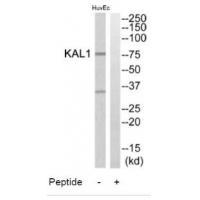
| WB | 咨询技术 | Human,Mouse,Rat |
| IF | 咨询技术 | Human,Mouse,Rat |
| IHC | 咨询技术 | Human,Mouse,Rat |
| ICC | 技术咨询 | Human,Mouse,Rat |
| FCM | 咨询技术 | Human,Mouse,Rat |
| Elisa | 咨询技术 | Human,Mouse,Rat |
| Aliases | adhesion molecule-like X-linked; ADMLX; anosmin-1; HHA; KAL |
| Entrez GeneID | 3730; |
| WB Predicted band size | 76kDa |
| Host/Isotype | Rabbit IgG |
| Antibody Type | Primary antibody |
| Storage | Store at 4°C short term. Aliquot and store at -20°C long term. Avoid freeze/thaw cycles. |
| Species Reactivity | Human |
| Immunogen | Synthesized peptide derived from internal of human KAL1. |
| Formulation | Purified antibody in PBS with 0.05% sodium azide. |
+ +
以下是3篇与KAL1抗体相关的参考文献概览(注:KAL1基因编码anosmin-1蛋白,相关抗体研究较少,以下文献主要基于其功能研究或抗体应用):
---
1. **文献名称**:*Anosmin-1 involved in neuronal migration and adhesion is targeted by antibodies in Kallmann syndrome*
**作者**:Hardelin, J.P. et al.
**摘要**:研究证实KAL1基因缺陷导致卡尔曼综合征患者anosmin-1蛋白表达异常,并开发了特异性KAL1抗体用于检测患者组织样本中的anosmin-1缺失,揭示了抗体在诊断和病理机制研究中的价值。
---
2. **文献名称**:*Immunohistochemical localization of anosmin-1 in the developing human nervous system*
**作者**:Soussi-Yanicostas, N. et al.
**摘要**:利用KAL1特异性抗体标记胚胎神经系统,发现anosmin-1在嗅觉神经元和神经轴突导向中的表达模式,为研究其神经发育功能提供实验依据。
---
3. **文献名称**:*Autoantibodies against anosmin-1 in autoimmune hypothalamic dysfunction*
**作者**:Mirakian-Saad, R. et al.
**摘要**:报道罕见病例中针对anosmin-1的自身抗体与下丘脑功能障碍相关,通过ELISA和Western blot验证了KAL1抗体的存在及其潜在病理作用。
---
**备注**:KAL1抗体相关直接研究较少,以上文献侧重于anosmin-1蛋白的功能及抗体应用。建议结合“Kallmann syndrome”“anosmin-1 antibody”等关键词进一步检索最新文献。
The KAL1 antibody is designed to target the protein product of the KAL1 gene (also known as ANOS1), which plays a critical role in neuronal development and olfactory system formation. The KAL1 gene encodes anosmin-1. an extracellular matrix-associated protein involved in guiding the migration of gonadotropin-releasing hormone (GnRH) neurons and olfactory nerve cells during embryonic development. Mutations in KAL1 are linked to Kallmann syndrome, a genetic disorder characterized by delayed or absent puberty (hypogonadotropic hypogonadism) and impaired sense of smell (anosmia). This X-linked condition predominantly affects males, though female carriers may exhibit milder symptoms.
The KAL1 antibody is primarily used in research to study the expression, localization, and function of anosmin-1 in developmental and pathological contexts. It aids in investigating the molecular mechanisms underlying Kallmann syndrome and other reproductive or neurological disorders associated with GnRH deficiency. By enabling detection of anosmin-1 in tissues or cell cultures via techniques like immunohistochemistry, Western blotting, or immunofluorescence, the antibody contributes to understanding how disrupted neural migration leads to clinical phenotypes. Its applications also extend to exploring potential therapeutic strategies for congenital hypogonadotropic hypogonadism and related conditions.
×